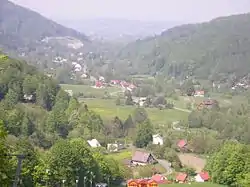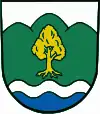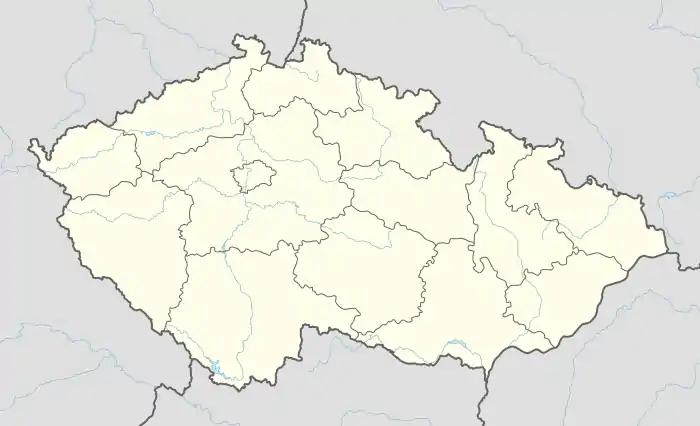Řeka
![]() Řeka (Polish:
Řeka (Polish: ![]() Rzeka, Cieszyn Silesian:
Rzeka, Cieszyn Silesian: ![]() Rzyka) (literally a river) is a village in Frýdek-Místek District, Moravian-Silesian Region, Czech Republic. It had a population of 466 (2001 census), 21.5% of the population are the Poles.[2] Village lies near the Moravian-Silesian Beskids mountains, and Ropičanka River flows through it. It lies in the historical region of Cieszyn Silesia.
Rzyka) (literally a river) is a village in Frýdek-Místek District, Moravian-Silesian Region, Czech Republic. It had a population of 466 (2001 census), 21.5% of the population are the Poles.[2] Village lies near the Moravian-Silesian Beskids mountains, and Ropičanka River flows through it. It lies in the historical region of Cieszyn Silesia.
Řeka
Rzeka | |
|---|---|
Village | |
 General view of the village | |
.svg.png.webp) Flag  Coat of arms | |
 Location in the Czech Republic | |
| Coordinates: 49°37′39″N 18°34′35″E | |
| Country | Czech Republic |
| Region | Moravian-Silesian |
| District | Frýdek-Místek |
| First mentioned | 1587 |
| Government | |
| • Mayor | Tomáš Tomeczek |
| Area | |
| • Total | 13.48 km2 (5.20 sq mi) |
| Elevation | 420 m (1,380 ft) |
| Population (2019)[1] | |
| • Total | 544 |
| • Density | 40/km2 (100/sq mi) |
| Postal code | 739 55 |
| Website | www |
History
The settlement along mountainous part of the Ropičanka River was led from Smilovice tracing back to the 16th century. In 1592 the noble owners of Smilovice had a litigation with Sidonia Catherine, the ruler of the Duchy of Teschen. From the accompanying document the established of the Řeka village can be inferred to happen around 1587.[3] In 1643 the village was mentioned as rzeka Smilowiczka, in 1647 as na Smilowskej Rzice, later on the adjective referring to Smilovice was dropped in the 19th century.[4] It belonged then to the Duchy of Teschen, a fee of the Kingdom of Bohemia and a part of the Habsburg Monarchy.
After Revolutions of 1848 in the Austrian Empire a modern municipal division was introduced in the re-established Austrian Silesia. The village as a municipality was subscribed to the political and legal district of Cieszyn. According to the censuses conducted in 1880, 1890, 1900 and 1910 the population of the municipality dropped from 524 in 1880 to 515 in 1910 with a majority being native Polish-speakers (between 95.5% and 99.6%) accompanied by a small German-speaking minority (at most 19 or 4.1% in 1890) and Czech-speaking people (growing from 1 or 0.2% in 1880 to 10 or 1.9% in 1910). In terms of religion in 1910 the majority were Protestants (92.6%), followed by Roman Catholics (6.8%) and 3 people adhering to another faiths (but not Jewish).[5] The village was also traditionally inhabited by Cieszyn Vlachs, speaking Cieszyn Silesian dialect.
After World War I, fall of Austria-Hungary, Polish–Czechoslovak War and the division of Cieszyn Silesia in 1920, it became a part of Czechoslovakia. Following the Munich Agreement, in October 1938 together with the Zaolzie region it was annexed by Poland, administratively adjoined to Cieszyn County of Silesian Voivodeship.[6] It was then annexed by Nazi Germany at the beginning of World War II. After the war it was restored to Czechoslovakia.
References
- "Population of municipalities of the Czech Republic". Czech Statistical Office. 1 January 2019.
- "2001 census data". Czech Statistical Office.
- Panic, Idzi (2011). Śląsk Cieszyński w początkach czasów nowożytnych (1528-1653) [Cieszyn Silesia in the beginnings of Modern Era (1528-1653)] (in Polish). Cieszyn: Starostwo Powiatowe w Cieszynie. p. 168. ISBN 978-83-926929-5-9.
- Mrózek, Robert (1984). Nazwy miejscowe dawnego Śląska Cieszyńskiego [Local names of the former Cieszyn Silesia] (in Polish). Katowice: Uniwersytet Śląski w Katowicach. p. 156. ISSN 0208-6336.
- Piątkowski, Kazimierz (1918). Stosunki narodowościowe w Księstwie Cieszyńskiem (in Polish). Cieszyn: Macierz Szkolna Księstwa Cieszyńskiego. pp. 265, 283.
- "Ustawa z dnia 27 października 1938 r. o podziale administracyjnym i tymczasowej organizacji administracji na obszarze Ziem Odzyskanych Śląska Cieszyńskiego". Dziennik Ustaw Śląskich (in Polish). Katowice. nr 18/1938, poz. 35. 31 October 1938. Retrieved 1 July 2014.

